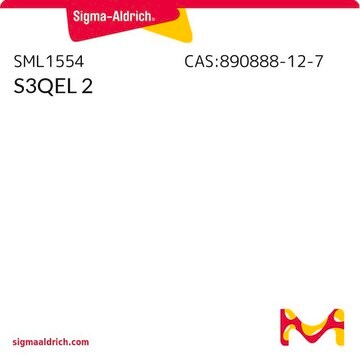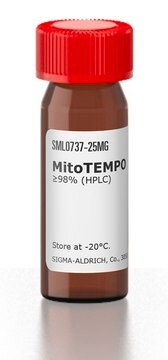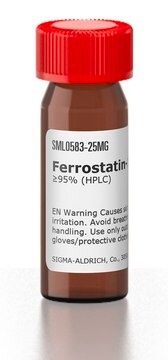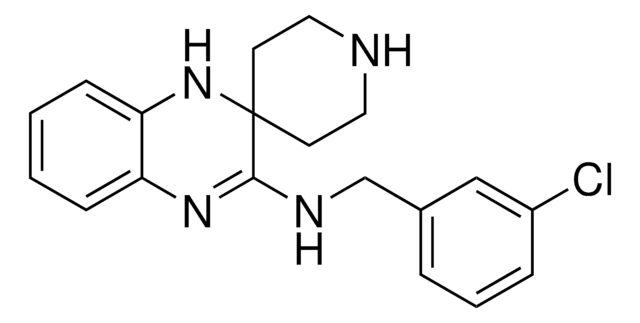Wszystkie zdjęcia(1)
Key Documents
SML1948
S1QEL1.1
≥98% (HPLC)
Synonim(y):
N1-(3-acetamidophenyl)-N2-(2-(4-methyl-2-(p-tolyl)thiazol-5-yl)ethyl)oxalamide, S1QEL
Zaloguj sięWyświetlanie cen organizacyjnych i kontraktowych
About This Item
Wzór empiryczny (zapis Hilla):
C23H24N4O3S
Numer CAS:
Masa cząsteczkowa:
436.53
Kod UNSPSC:
12352200
NACRES:
NA.77
Polecane produkty
Poziom jakości
Próba
≥98% (HPLC)
Postać
powder
kolor
white to beige
rozpuszczalność
DMSO: 2 mg/mL, clear
Warunki transportu
wet ice
temp. przechowywania
−20°C
ciąg SMILES
CC1=C(CCNC(C(NC2=CC=CC(NC(C)=O)=C2)=O)=O)SC(C3=CC=C(C)C=C3)=N1
Zastosowanie
S1QEL1.1 has been used as a reverse electron transport (RET)-induced mitochondrial (mito) reactive oxygen species (ROS) suppressor:
- to investigate the role of mitochondrial-derived superoxide in triggering ferroptosis
- to study the mechanism involved in the regulation of anti-fungal responses of macrophages against Aspergillus infection
- in combination with mito-antioxidant to study their influence on mitochondria-derived H2O2 in cancer cells
- to determine the effect of oxidative stress depletion on myoblast differentiation
Działania biochem./fizjol.
S1QEL1.1 is a suppressor of mitochondrial respiratory complex I site IQ electron leak, suppressing superoxide and/or H2O2 production without altering oxidative phosphorylation. S1QEL1.1 had an IC50 values of 70 nM against superoxide-H2O2 production from site IQ. It decreased caspase activation in a in a cardiomyocyte cell model of ER stress and decreased ischemia-reperfusion injury in the Langendorff-perfused mouse heart model.
Suppressors of the site IQ electron leak (S1QEL)1.1 reduces cytokine secretion and fungicidal activity of macrophages infected with swollen A. fumigatus conidia by suppressing reverse electron transport (RET)-induced mitochondrial reactive oxygen species (ROS).
This page may contain text that has been machine translated.
Kod klasy składowania
11 - Combustible Solids
Klasa zagrożenia wodnego (WGK)
WGK 3
Temperatura zapłonu (°F)
Not applicable
Temperatura zapłonu (°C)
Not applicable
Certyfikaty analizy (CoA)
Poszukaj Certyfikaty analizy (CoA), wpisując numer partii/serii produktów. Numery serii i partii można znaleźć na etykiecie produktu po słowach „seria” lub „partia”.
Masz już ten produkt?
Dokumenty związane z niedawno zakupionymi produktami zostały zamieszczone w Bibliotece dokumentów.
Martin D Brand et al.
Cell metabolism, 24(4), 582-592 (2016-09-27)
Using high-throughput screening we identified small molecules that suppress superoxide and/or H
Takujiro Homma et al.
Archives of biochemistry and biophysics, 700, 108775-108775 (2021-01-26)
Ferroptosis is a type of iron-dependent, non-apoptotic cell death, which is typically induced by cysteine starvation or by the inhibition of glutathione peroxidase 4 (GPX4) activity with the accompanying elevation in lipid peroxidation product levels. Despite the central role of
Remi Hatinguais et al.
Frontiers in immunology, 12, 641495-641495 (2021-04-13)
Reactive Oxygen Species (ROS) are highly reactive molecules that can induce oxidative stress. For instance, the oxidative burst of immune cells is well known for its ability to inhibit the growth of invading pathogens. However, ROS also mediate redox signalling
Nasz zespół naukowców ma doświadczenie we wszystkich obszarach badań, w tym w naukach przyrodniczych, materiałoznawstwie, syntezie chemicznej, chromatografii, analityce i wielu innych dziedzinach.
Skontaktuj się z zespołem ds. pomocy technicznej








